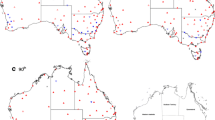Abstract
The recent Third Assessment Report (TAR) of the Intergovernmental Panel onClimate Change (IPCC) indicated that observed 20th century changes in severalclimatic extremes are qualitatively consistent with those expected due to increasedgreenhouse gases. However, a lack of adequate data and analyses make conclusiveevidence of changing extremes somewhat difficult, particularly, in a global sense.In Canada, extreme temperature events, especially those during winter, can havemany adverse environmental and economic impacts. In light of the aforementionedIPCC report, the main focus of this analysis is to examine observed trends andvariability in the frequency, duration, and intensity of winter (Jan–Feb–Mar) cold and warm spells over Canada during the second half of the 20th century.
Cold spell trends display substantial spatial variability across the country. From1950–1998, western Canada has experienced decreases in the frequency, duration, and intensity of cold spells, while in the east, distinct increases in the frequency and duration have occurred. These increases are likely associated with morefrequent occurrences of the positive phase of the North Atlantic Oscillation (NAO)during the last several decades. With regard to winter warm spells, significantincreases in both the frequency and duration of these episodes were observedacross most of Canada. One exception was found in the extreme northeasternregions, where warm spells are becoming shorter and less frequent. The resultsof this study are discussed within the context of climate warming expectations.
Similar content being viewed by others
References
Bonsal, B. R., Shabbar, A., and Higuchi, K.: 2001a, Impacts of low frequency variability modes on Canadian winter temperature, Int. J. Climatol. 21, 95–108.
Bonsal, B. R., Zhang, X., Vincent, L. A., and Hogg, W. D.: 2001b, Characteristics of daily and extreme temperatures over Canada, J. Climate 14, 1959–1976.
Hoerling, M. P., Hurrell, J. W., and Xu, T.: 2001, Tropical origins for recent North Atlantic climate change, Science 292, 90–92.
IPCC: 2001, In J. T. Houghton, Y. Ding, D. J. Griggs, M. Noguer, P. J. van der Linder, X. Dai, K. Maskell and C.A. Johnson (eds), Climate Change 2001. The scientific Basis, Cambridge University Press, 881 pp.
Karl, T. R., Nicholls, N., and Ghazi, A.: 1999, CLIVAR/ GCOS/WMO workshop on indices and indicators for climate extremes, Climatic Change 42, 3–7.
Kharin, V. V. and Zwiers, F. W.: 2000, Changes in the extremes in an ensemble of transient climate simulations with a coupled atmosphere-ocean GCM, J. Climate 13, 3760–3788.
Mantua, N. J., Hare, S. R., Zhang, Y., Wallace, J. M., and Francis, R.C.: 1997, A Pacific interdecadal climate oscillation with impacts on salmon production, Bull. Am. Met. Soc. 78, 1069–1079.
Rice, J. A.: 1995, Mathematical Statistics and Data Analysis, second edition. Duxbury press, 602 pp.
Sen, P. K.: 1968, Estimates of the regression coefficient based on Kendall's Tau', J. Amer. Stat. Assoc. 63, 1379–1389.
Shabbar, A. and Khandekar, M.: 1996, The impact of El Niño-Southern Oscillation on the temperature field over Canada, Atm. Ocean 34, 401–416.
Shabbar, A., Higuchi, K., Skinner, W., and Knox, J. L.: 1997, The association between the BWA index and winter surface temperature variability over eastern Canada and west Greenland, Int. J. Climatol. 17, 1094–1104.
Statistics Canada: 1998, Canadian Centre for Health Information, causes of death. Catalogue No. 84-208, Minister of Supply and Services Canada, 335 pp.
Thompson, D. W. and Wallace, J. M.: 2000, Annular modes in the extratropical circulation. Part I: Month to month variability, J. Climate 13, 1000–1016.
Vincent, L.A.: 1998, A technique for the identification of in homogeneities in Canadian temperature series, J. Climate 11, 1094–1104.
Vincent, L. A. and Gullett, D.W: 1999, Creation of historical and homogeneous temperature datasets for climate change analyses in Canada, Int J. Climatol. 19, 1375–1388.
Vincent, L. A., Zhang, X., Bonsal, B. R., and Hogg, W. D.: 2002: Homogenization of daily temperatures over Canada, accepted in J. Climate 15, 1322–1334.
Wilks, D. S.: 1995, Statistical Methods in Atmospheric Sciences, Academic press, 467 pp.
Zhang, X., Vincent, L. A., Hogg, W. D., and Niitsoo, A.: 2000, Temperature and precipitation trends in Canada during the 20th century, Atm. Ocean 38, 395–429.
Author information
Authors and Affiliations
Rights and permissions
About this article
Cite this article
Shabbar, A., Bonsal, B. An Assessment of Changes in Winter Cold and Warm Spells over Canada. Natural Hazards 29, 173–188 (2003). https://doi.org/10.1023/A:1023639209987
Issue Date:
DOI: https://doi.org/10.1023/A:1023639209987




